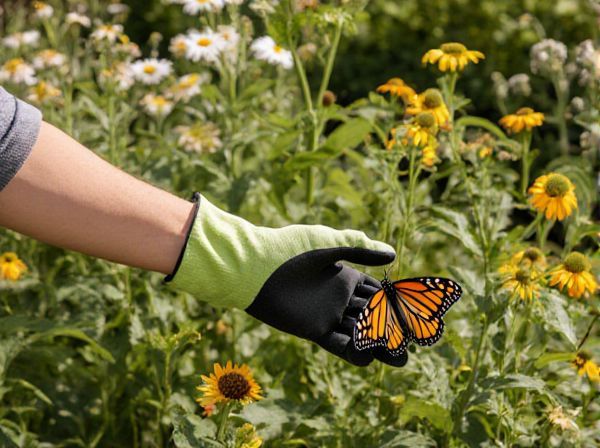
Pollinator Garden vs Moon Garden Illustration
A Pollinator Garden is designed to attract bees, butterflies, and other pollinators with brightly colored, nectar-rich flowers, promoting biodiversity and supporting ecosystem health. In contrast, a Moon Garden features plants with pale or white blossoms that reflect moonlight, creating a serene and enchanting nighttime ambiance perfect for evening enjoyment. Both garden styles offer unique aesthetic and ecological benefits tailored to different sensory experiences and environmental goals.
Table of Comparison
| Feature | Pollinator Garden | Moon Garden |
|---|---|---|
| Primary Purpose | Attracts bees, butterflies, and hummingbirds | Enhances nighttime garden aesthetics |
| Key Plants | Milkweed, Coneflower, Butterfly Bush | Moonflower, Jasmine, White Gardenia |
| Color Palette | Bright, vibrant colors (yellow, purple, red) | White, silver, pale hues |
| Best Viewing Time | Daytime | Evening and night |
| Pollinator Support | High - vital for ecosystem health | Low - primarily ornamental |
| Fragrance | Varies; often mild or floral | Strong, sweet, night-blooming fragrance |
| Lighting Needs | Full sun | Partial to full shade preferred |
| Common Uses | Support biodiversity and garden vitality | Nighttime relaxation and ambiance |
Understanding Pollinator Gardens
Pollinator gardens are specifically designed to attract and support beneficial insects such as bees, butterflies, and hummingbirds by featuring a diverse range of native flowering plants that provide nectar and pollen throughout the growing season. These gardens contribute to ecosystem health by enhancing biodiversity and improving pollination rates for surrounding plants. In contrast, moon gardens emphasize fragrant, white or light-colored flowers that bloom at night, primarily serving aesthetic and sensory purposes rather than ecological support for pollinators.
Exploring the Concept of Moon Gardens
Moon gardens emphasize nocturnal beauty by featuring plants with white or pale blooms and strong fragrances that attract night pollinators like moths and bats. Unlike pollinator gardens that focus on daytime pollinators such as bees and butterflies, moon gardens create a serene nighttime landscape that enhances visibility in low light with reflective foliage and silver-leafed plants. This design maximizes aesthetic appeal and ecological benefits during evening hours, supporting a diverse range of pollinators active after sunset.
Key Differences: Pollinator Garden vs Moon Garden
Pollinator gardens are designed with native flowering plants that attract bees, butterflies, and hummingbirds, supporting local ecosystems and biodiversity. Moon gardens focus on white or pale-colored flowers and fragrant plants that thrive in low light, creating a luminous nighttime landscape. While pollinator gardens enhance daytime ecological activity, moon gardens provide aesthetic appeal and sensory experiences during evening hours.
Plant Selection for Pollinator Gardens
Pollinator gardens prioritize native flowering plants such as milkweed, coneflowers, and bee balm that attract bees, butterflies, and hummingbirds essential for ecosystem health. In contrast, moon gardens feature plants like white jasmine and evening primrose chosen for their nighttime fragrance and light-colored blooms. Selecting diverse nectar-rich plants with staggered bloom times enhances pollinator activity and supports local biodiversity year-round.
Ideal Plants for Moon Gardens
Moon gardens thrive with plants that reflect and enhance nighttime ambiance, such as white or pale flowers like white phlox, moonflower, and evening primrose, which glow softly under moonlight. Fragrant varieties such as night-blooming jasmine and nicotiana attract nocturnal pollinators like moths and bats, supporting biodiversity while adding sensory appeal. Incorporating silver-leaved plants like Artemisia and Lamb's ear emphasizes texture and color contrast, creating a serene, luminous landscape suited for evening enjoyment.
Benefits of Attracting Pollinators
Pollinator gardens enhance biodiversity by attracting essential species such as bees, butterflies, and hummingbirds, which improve plant reproduction and ecosystem health. Moon gardens, designed to bloom and emit fragrance at night, attract nocturnal pollinators like moths and bats, supporting unique pollination cycles and increasing garden vitality. Both garden types contribute to sustainable gardening by fostering pollinator populations critical for food production and environmental balance.
Creating Evening Appeal with Moon Gardens
Moon gardens create evening appeal by featuring night-blooming plants such as white moonflowers and fragrant evening primrose that attract nocturnal pollinators like moths and bats. Incorporating reflective elements and light-colored foliage enhances visibility under moonlight, boosting the garden's charm after dusk. Unlike pollinator gardens that focus on daytime pollinators, moon gardens extend ecological benefits into the night, supporting a diverse range of species and prolonging garden enjoyment.
Design Tips for Each Garden Style
Pollinator gardens thrive with a diverse mix of native flowering plants that provide nectar and pollen for bees, butterflies, and hummingbirds, ensuring continuous blooms from early spring to late fall. Moon gardens emphasize pale-colored, fragrant flowers and reflective foliage that glow under moonlight, complemented by strategic paths and seating to create a serene nighttime experience. For effective design, combine layered plant heights in pollinator gardens to maximize habitat, while moon gardens benefit from white or silver foliage paired with subtle lighting to enhance nocturnal appeal.
Maintenance Considerations for Both Gardens
Pollinator gardens require consistent maintenance, including regular watering, pruning, and monitoring for pests to ensure healthy attractants like native bees and butterflies. Moon gardens demand careful selection of low-maintenance, night-blooming plants such as white or silver foliage to maximize visual appeal under moonlight with minimal upkeep. Both garden types benefit from organic mulching and seasonal clean-up to support plant health and sustain their specialized ecosystems.
Choosing the Right Garden for Your Space
Choosing the right garden for your space depends on your goals and environmental conditions; pollinator gardens prioritize attracting bees, butterflies, and hummingbirds with a variety of nectar-rich plants like milkweed and coneflowers. Moon gardens emphasize night-blooming flowers such as evening primrose, moonflower, and jasmine to create a luminous, fragrance-filled landscape ideal for nighttime enjoyment. Assess sunlight availability, space constraints, and desired sensory experiences to create either a vibrant habitat supporting pollinators or a serene nocturnal retreat.
Pollinator Garden vs Moon Garden Infographic

 gardendif.com
gardendif.com